The Siege of Zara in 1202 was the first major action of the Fourth Crusade and the first attack against a Catholic city by Catholic crusaders.
Siege of Zadar may also refer to:

Zadar, historically known as Zara, is the oldest continuously inhabited city in Croatia. It is situated on the Adriatic Sea, at the northwestern part of Ravni Kotari region. Zadar serves as the seat of Zadar County and of the wider northern Dalmatian region. The city proper covers 25 km2 (9.7 sq mi) with a population of 75,082 in 2011, making it the second-largest city of the region of Dalmatia and the fifth-largest city in the country.

The Kingdom of Croatia entered a personal union with the Kingdom of Hungary in 1102, after a period of rule of kings from the Trpimirović and Svetoslavić dynasties and a succession crisis following the death of king Demetrius Zvonimir. With the coronation of King Coloman of Hungary as "King of Croatia and Dalmatia" in 1102 in Biograd, the realm passed to the Árpád dynasty until 1301, when the (male) line of the dynasty died out. Then, kings from the Capetian House of Anjou, who were also cognatic descendants of the Árpád kings, ruled the kingdoms. Later centuries were characterized by conflicts with the Mongols, who sacked Zagreb in 1242, competition with Venice for control over Dalmatian coastal cities, and internal warfare among Croatian nobility. Various individuals emerged during the period, such as Paul I Šubić of Bribir, who was representing the most powerful Croatian dynasty at the time, the Šubić noble family. These powerful individuals were on occasion able to de facto secure great deal of independence for their fiefdoms. The Ottoman incursion into Europe in the 16th century significantly reduced Croatian territories and left the country weak and divided. After the death of Louis II in 1526 during the Battle of Mohács and a brief period of dynastic dispute, both crowns passed to the Austrian House of Habsburg, and the realms became part of the Habsburg monarchy.

Biograd na Moru, shortened to simply Biograd is a town in northern Dalmatia, Croatia and is significant for being another capital of the medieval Kingdom of Croatia. Biograd is administratively part of the Zadar County. It is located on the Adriatic Sea coast, overlooking the island of Pašman, on the road from Zadar and Sukošan towards Vodice and Šibenik.
The History of Dalmatia concerns the history of the area that covers eastern coast of the Adriatic Sea and its inland regions, from the 2nd century BC up to the present day. The earliest mention of Dalmatia as a province came after its establishment as part of the Roman Empire. Dalmatia was ravaged by barbaric tribes in the beginning of the 4th century. Slavs settled in the area in the 6th century, the White Croats settled Dalmatia the following century.

The siege of Zara or siege of Zadar was the first major action of the Fourth Crusade and the first attack against a Catholic city by Catholic crusaders. The crusaders had an agreement with Venice for transport across the sea, but the price far exceeded what they were able to pay. Venice set the condition that the crusaders help them capture Zadar, a constant battleground between Venice on one side and Croatia and Hungary on the other, whose king, Emeric, pledged himself to join the Crusade. Although some of the crusaders refused to take part in the siege, the attack on Zadar began in November 1202 despite letters from Pope Innocent III forbidding such an action and threatening excommunication. Zadar fell on 24 November and the Venetians and the crusaders sacked the city. After wintering in Zadar, the Fourth Crusade continued its campaign, which led to the siege of Constantinople.
The military history of the Republic of Venice started shortly after its founding, spanning a period from the 9th century until the Republic's fall in the 18th century.
The 1991 riot in Zadar was an act of violence that took place in the Croatian city of Zadar on 2 May 1991. Following an incident in the Zadar hinterland in which a Croatian policeman was killed, reportedly by SAO Krajina militiamen, Croatian civilians vandalized, destroyed and looted properties belonging to ethnic Serbs and Yugoslav companies in the city.

The bombing of Zadar during the Second World War by the Allies lasted from November 1943 to October 1944. Although other large cities in Italy were also bombed, the bombing of Zadar stands out because of the number of attacks and the number of fatalities. Reports vary greatly; the Allies documented 30 bombing raids, while contemporary Italian accounts claim 54. Fatalities recorded range from under 1,000 to as many as 4,000 of the city's 20,000 inhabitants.

The Archdiocese of Zadar is a Latin Church ecclesiastical territory or archdiocese of the Catholic church in Croatia. The diocese was established in the 3rd century AD and was made an archdiocese by the Pope Anastasius IV in 1154. Today, it is not part of any ecclesiastical province of Croatia, rather it is the only Croatian archdiocese directly subject to the Holy See.
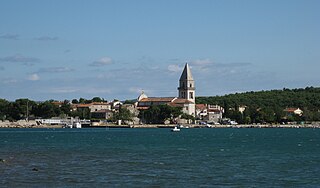
Osor is a village and a small port on the Croatian island of Cres, in Primorje-Gorski Kotar county. Administratively, it is part of the town of Mali Lošinj. As of 2021, it had a population of 26.
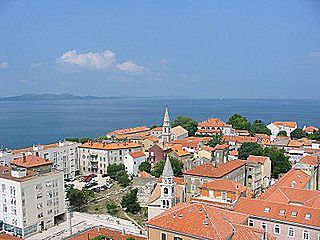
Dalmatian Italians are the historical Italian national minority living in the region of Dalmatia, now part of Croatia and Montenegro.
The Battle of Zadar was a military engagement between the Yugoslav People's Army, supported by the Croatian Serb Serbian Autonomous Oblast of Krajina, and the Croatian National Guard, supported by the Croatian Police. The battle was fought north and east of the city of Zadar, Croatia, in the second half of September and early October 1991 during the Croatian War of Independence. Although the JNA's initial orders were to lift the Croatian siege of the JNA's barracks in the city and isolate the region of Dalmatia from the rest of Croatia, the orders were amended during the battle to include capturing the Port of Zadar in the city centre. The JNA's advance was supported by the Yugoslav Air Force and Navy.
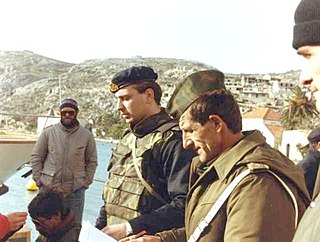
The 1991 Yugoslav campaign in Croatia was a series of engagements between the Yugoslav People's Army (JNA), the Yugoslav Navy and the Yugoslav Air Force, and the Croatian National Guard (ZNG) then the Croatian Army (HV) during the Croatian War of Independence. The JNA was originally deployed in order to preserve Yugoslavia, and the initial plan of the campaign entailed the military occupation of Croatia and the removal of the Croatian leadership elected in 1990. The JNA intervention was the culmination of its involvement in the confiscation of weapons from Croatia's Territorial Defence, and in the Croatian Serb revolt that had begun in August 1990. From that time, the JNA had been frequently deployed to form a buffer zone between the insurgents and the ZNG or the Croatian police. In effect, these JNA buffer zones often secured the territorial gains of the insurgents and led to an increasingly hostile relationship between the JNA and Croatia. The JNA campaign plan was amended shortly before the campaign to include the relief of JNA barracks besieged by the ZNG. The besieging and subsequent capture of several JNA facilities allowed Croatia to arm its previously poorly equipped military and to equip new recruits.
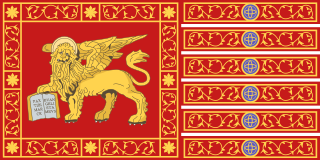
Venetian Dalmatia refers to parts of Dalmatia under the rule of the Republic of Venice, mainly from the 15th to the 18th centuries. Dalmatia was first sold to Venice in 1409 but Venetian Dalmatia was not fully consolidated until 1420. It lasted until 1797, when the Republic of Venice fell to the forces of Napoleon Bonaparte and Habsburg Austria.

The siege of Zadar in 998 was part of the third Croatian–Bulgarian war and one of the last military conflicts between Croatian forces of King Svetoslav Suronja, supported by Venice and the Byzantine Empire, and the army of Emperor Samuil, who launched a large-scale Bulgarian military campaign against the Kingdom of Croatia.

Croatia–Holy See relations refer to the bilateral relationship between Croatia and the Holy See. Diplomatic relations among the two countries were established on February 8, 1992, following Croatia's independence from SFR Yugoslavia, although they date far back in history.
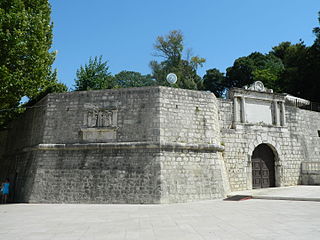
The siege of Zara or siege of Zadar, also known as the blockade of Zara, was a military event that took place between 22 November and 5 December 1813, during the Adriatic Campaign of the Napoleonic Wars. During the siege, an Anglo-Austrian force under command of George Cadogan in HMS Havannah blockaded and bombarded Zara which was then held by a French garrison. Within two weeks, the garrison surrendered to the attackers.

The siege of Zadar was a successful attempt of the Republic of Venice to capture Zadar, a Croatian coastal city in northern Dalmatia. It was a combined land and sea offensive by the Venetians, consisting of many separate battles and operations against the citizens of Zadar, who refused to accept Venetian suzerainty and demanded autonomy. Despite receiving military aid from Croato-Hungarian king Louis the Angevin, Zadar was unable to resist the siege and was finally defeated.
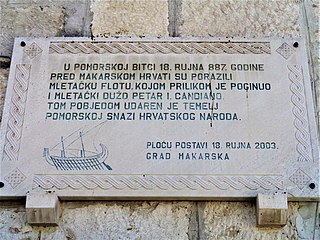
The Croatian–Venetian wars were a series of periodical, punctuated medieval conflicts and naval campaigns waged for control of the northeastern coast of the Adriatic Sea between the city-state of Venice and the Principality of Croatia, at times allied with neighbouring territories – the Principality of the Narentines and Zahumlje in the south and Istrian peninsula in the north. First struggles occurred at the very beginning of the existence of two conflict parties, they intensified in the 9th century, lessened during the 10th century, but intensified again since the beginning of the 11th century.